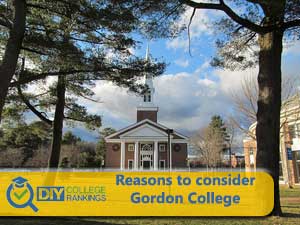
Gordan College-Private
Wenham, Massachusetts (Boston-Cambridge-Newton, MA-NH)
1,816 (1,451 undergraduates)
Does College Size Matter?

Wenham, Massachusetts (Boston-Cambridge-Newton, MA-NH)
1,816 (1,451 undergraduates)
Does College Size Matter?
 There are over 1,600 four-year public and private colleges in the United States. And guess what, they don’t all cost an arm and a leg to attend. With this many colleges, there have to be quality, affordable options available for families who look for them. And there are students attending college without facing the prospect of years of debilitating debt. Yet, attending affordable colleges comes with some trade-offs that not all families are willing to make.
There are over 1,600 four-year public and private colleges in the United States. And guess what, they don’t all cost an arm and a leg to attend. With this many colleges, there have to be quality, affordable options available for families who look for them. And there are students attending college without facing the prospect of years of debilitating debt. Yet, attending affordable colleges comes with some trade-offs that not all families are willing to make.

Saint Paul, Minnesota (Minneapolis-St. Paul, MN-WICSA)
9,792 (6,333 undergraduates)
Does College Size Matter?
 (Updated for 2022) If you want to play on a college softball team, you should probably be looking in California, Pennsylvania, or New York. However, if you’re looking specifically for Junior College teams, you should be focusing on Illinois and Texas. The states with the most D1 softball programs are California, New York, and Texas. The D3 college softball teams are concentrated in Pennsylvania, New York, and Massachusetts.
(Updated for 2022) If you want to play on a college softball team, you should probably be looking in California, Pennsylvania, or New York. However, if you’re looking specifically for Junior College teams, you should be focusing on Illinois and Texas. The states with the most D1 softball programs are California, New York, and Texas. The D3 college softball teams are concentrated in Pennsylvania, New York, and Massachusetts.

Muncie, Indiana (Indianapolis-Carmel-Muncie, IN CSA)
21,597 (15,780 undergraduates)
Does College Size Matter?

Saint Petersburg, Florida, (Tampa-St. Petersburg-Clearwater, FL)
1,822 (all undergraduates)
Does College Size Matter?
 50–that’s the number of colleges you should target if you’re interested in getting to play college baseball at the college level. Too many? Think I might be exaggerating a little? Or maybe I don’t have a clue as to what I’m talking about? Give me a moment and I’ll explain my madness.
50–that’s the number of colleges you should target if you’re interested in getting to play college baseball at the college level. Too many? Think I might be exaggerating a little? Or maybe I don’t have a clue as to what I’m talking about? Give me a moment and I’ll explain my madness.

Selinsgrove, Pennsylvania (Bloomsburg-Berwick-Sunbury, PA CSA)
2,241 (2,239 undergraduates)
Does College Size Matter?
 If you want to pay less for college, you need to pay more attention to college statistics. I’m sure many parents and students hip deep in the college admissions process think that they are drowning in college statistics but are still facing the prospect of impossible tuition bills. The problem is that they aren’t paying attention to the right statistics, or at the very least, not considering them in terms of how they affect the cost of going to college.
If you want to pay less for college, you need to pay more attention to college statistics. I’m sure many parents and students hip deep in the college admissions process think that they are drowning in college statistics but are still facing the prospect of impossible tuition bills. The problem is that they aren’t paying attention to the right statistics, or at the very least, not considering them in terms of how they affect the cost of going to college.